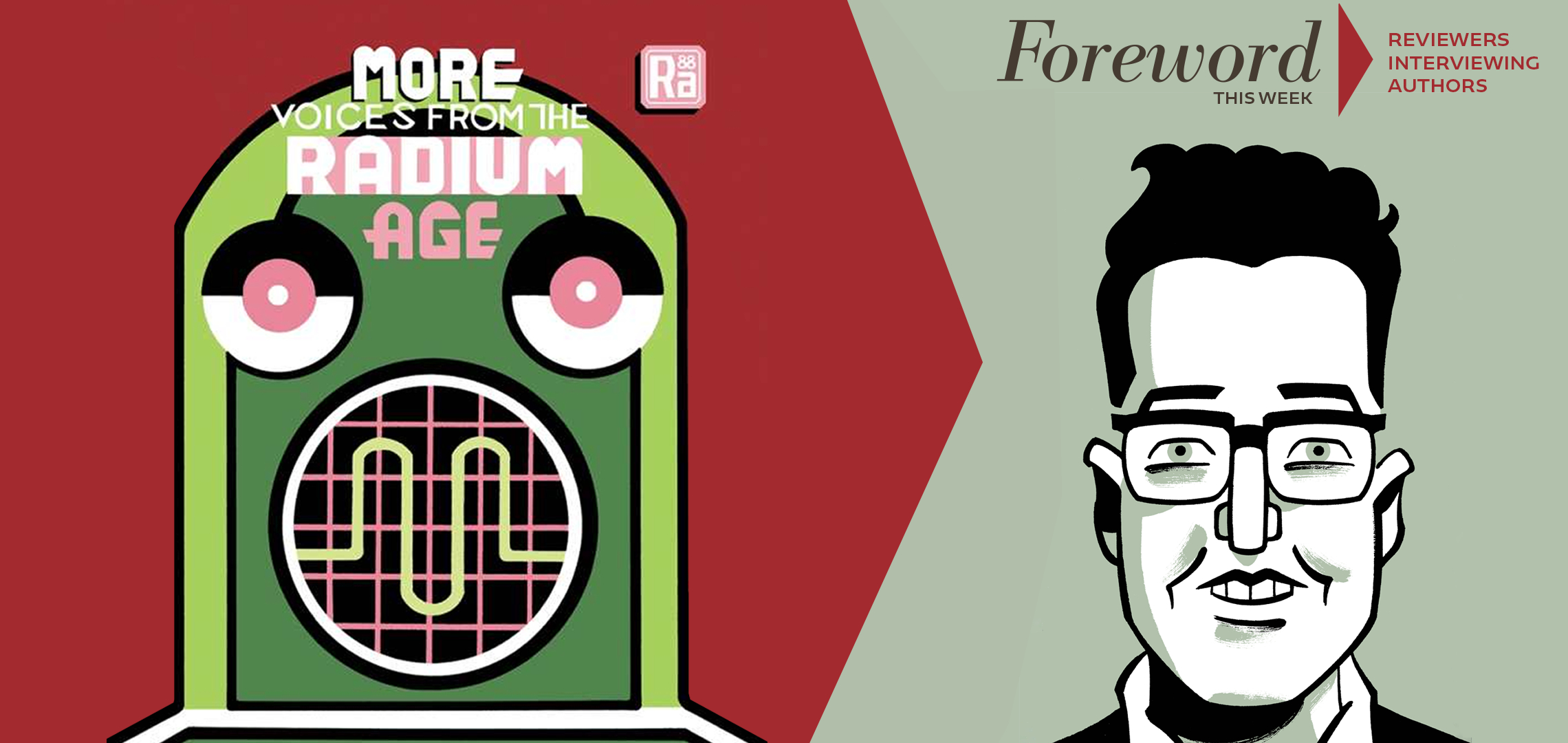RADIUM AGE 2023
By:
December 29, 2023

Under the direction of HILOBROW’s Josh Glenn, in 2022 the MIT Press launched its RADIUM AGE series of proto-sf reissues (from 1900–1935).
In these forgotten classics, sf readers will discover the origins of enduring tropes like robots (berserk or benevolent), tyrannical supermen, dystopias and apocalypses, sinister telepaths, and eco-catastrophes. With new contributions by historians, science journalists, and sf authors, the RADIUM AGE book series recontextualizes the breakthroughs and biases of these proto-sf pioneers, and charts the emergence of a burgeoning literary genre.
RADIUM AGE SERIES UPDATES: 2022 | 2023 | 2024 | 1Q2025 | 2Q2025. FULL SERIES INFO.
Below, please find updates on the RADIUM AGE project from 2023.
During 2023, the following five titles were published….
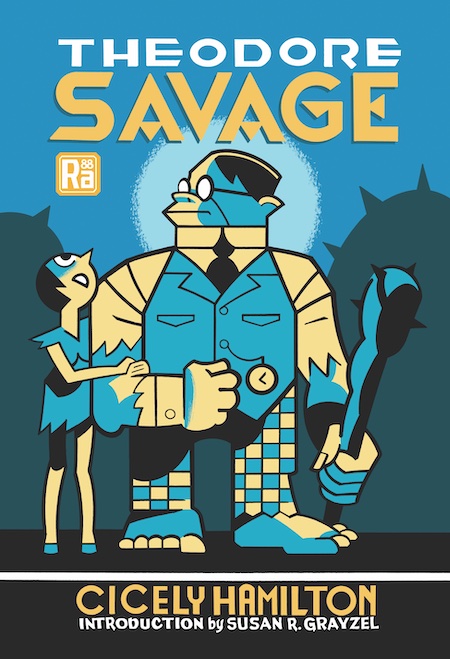
Cicely Hamilton’s THEODORE SAVAGE (Feb. 7, introduction by Susan R. Grayzel). “Miss Hamilton always writes forcibly, and her present novel deals with the heart-shaking effects of the next war. It might, indeed, be used as a tract to convey an awful warning.” — The Spectator (1922). “Challenging last century’s assumptions about the invulnerability of imperial civilization, Cicely Hamilton’s 1922 novel is a grim, swift read — and an argument for pacifism as the first principle of survival.” — Nisi Shawl.
Press for MITP’s edition of Theodore Savage includes the following…
“The writing is brilliant, nuanced, and deep. No aspect of the hellish aftermath of scientific warfare is unexplored. […] A terrifying and prescient science fiction novel that’s unflinching in its portrayal of the fragile scaffolding that supports ‘civilized’ society. — Foreword
“Decades later, scores of novels about the aftermath of nuclear war would deploy a similar gambit; few are quite this effective. Reading [Hamilton’s] tale of misanthropy and hopelessness is a scarring experience.” — Michael D. Gordin, Los Angeles Review of Books
“Hamilton drew on the anxieties and trauma that emerged from the First World War to tell a story of a Europe decimated by war — and to explore how society and gender roles had drastically changed as a result.” — Tor.com’s list of “Can’t Miss Indie Press Speculative Fiction for January and February 2023”
Cover illustrated and designed by Seth. See this book at MIT Press.
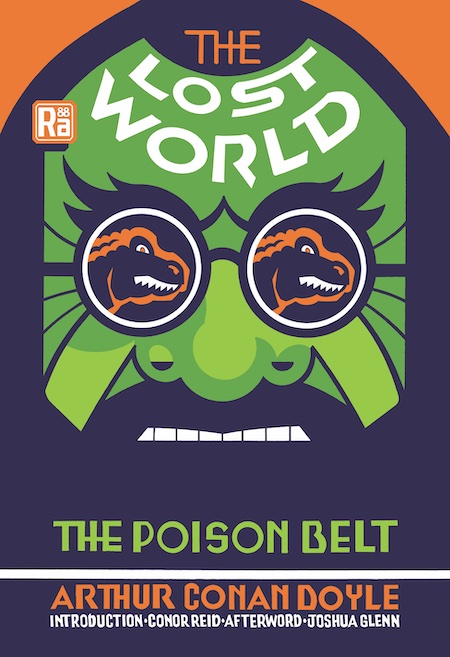
Arthur Conan Doyle’s THE LOST WORLD and THE POISON BELT (Feb. 21, introduction by Conor Reid, afterword by Joshua Glenn). “The last word in the sensational. No less interesting than the feats of Sherlock Holmes.” — Pittsburgh Gazette-Times (1912). “[MIT Press’s] The Lost World and The Poison Belt is a wonderful snapshot of the Edwardian scientific mind, both its virtues and its defects.” — Katherine Addison.
Press for MITP’s edition of The Lost World and The Poison Belt includes the following…
“The irascible Professor Challenger [is] a genius as likely to crack an inquiring journalist’s skull as the mysteries of the universe.” — Michael D. Gordin, Los Angeles Review of Books
“Written when Europe’s attempts to conquer time and space through technological means threatened to disenchant a rapidly contracting globe, Doyle’s Professor Challenger series made the planet and its processes strange again.” — Sasha Karsavina, Los Angeles Review of Books
“An excellent addition to the Radium Age series, in that it is both an important contribution to the development of science fiction and enjoyable to read.” — PopScienceBooks
Cover illustrated and designed by Seth. See this book at MIT Press.
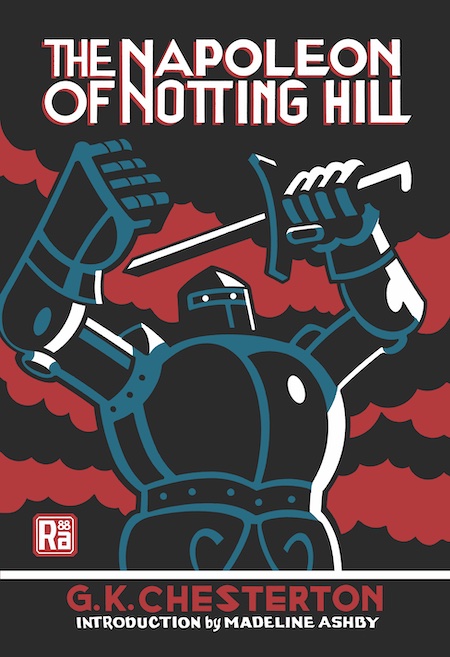
G.K. Chesterton’s THE NAPOLEON of NOTTING HILL (August 1, introduction by Madeline Ashby). “A vastly entertaining book, which should be breathlessly enjoyed at Notting Hill and elsewhere.” — Daily Chronicle (1904). “More modern than the moderns, more medieval than the medievalists, funnier than all of them — reading Chesterton today is like watching someone give a speech of unimpeachable common sense from the bridge of a departing UFO.” — James Parker.
Press for MITP’s edition of The Napoleon of Notting Hill includes the following…
“Unquestionably a satirical masterpiece” — Michael D. Gordin, Los Angeles Review of Books
“A fascinating study of arrogance and folly, of progress and tradition and, oddly, of human nature itself.” — Fortean Times
Cover illustrated and designed by Seth. See this book at The MIT Press.
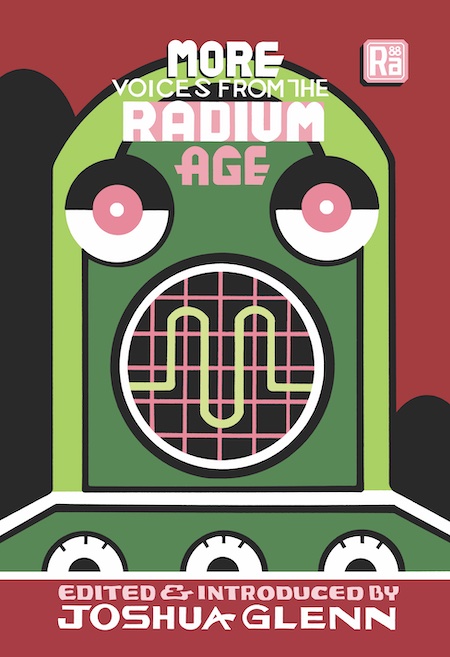
MORE VOICES from the RADIUM AGE (August 1, edited and introduced by Joshua Glenn). An essential collection for any sci fi fan, More Voices from the Radium Age is a wild and darkly cathartic ride through the anxieties, fantasies, and nightmares that ultimately shaped the genre we now know as science fiction.
Press for More Voices from the Radium Age includes the following…
“A diverse, captivating collection… highlighting neglected voices in speculative and science fiction. These stories are sharp and relevant, addressing issues including climate change, women’s equality, advanced technologies, parallel universes, and dystopian societies.” — Foreword (starred review)
“Reprints, among other good things, A. Merritt’s ‘The People of the Pit’ (1918), a story that could have served as the template for half of Lovecraft’s contributions to Weird Tales. Deliciously florid.” — Michael Dirda, The Washington Post
Cover illustrated and designed by Seth. See this book at The MIT Press.
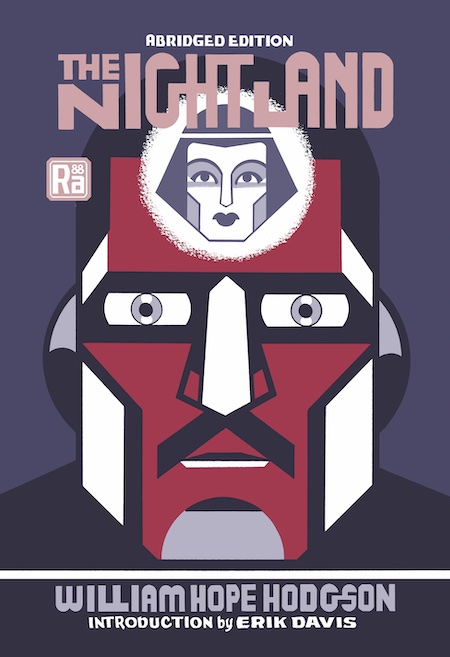
William Hope Hodgson’s THE NIGHT LAND (ABRIDGED) (August 15, introduced by Erik Davis). “One of the most potent pieces of macabre imagination ever written.” — H.P. Lovecraft (1927). “For all its flaws and idiosyncracies, The Night Land is utterly unsurpassed, unique, astounding. A mutant vision like nothing else there has ever been.” — China Miéville.
Press for MITP’s edition of The Night Land includes the following…
“William Hope Hodgson’s extravagantly baroque vision of a desolate future Earth.” — Michael Dirda, The Washington Post
“The most extreme inquiry into human dependence on technology in the face of a nature perpetually degenerating into monstrosity and entropic heat death.” | “Hodgson was clearly an inspiration for generations of writers such as H. P. Lovecraft, who learned a thing or two about hideous monsters from texts like this one.” — Michael D. Gordin, Los Angeles Review of Books
“The strangest and most ensorcelling of novels…” | “An absolutely bonkers masterpiece.” | “One of the most rewarding reading experiences of the year for me. It’s a book I know I’ll read again and revisit in reveries for the rest of my life.” — J.F. Martel, Weird Studies podcast
Cover illustrated and designed by Seth. See this book at The MIT Press.
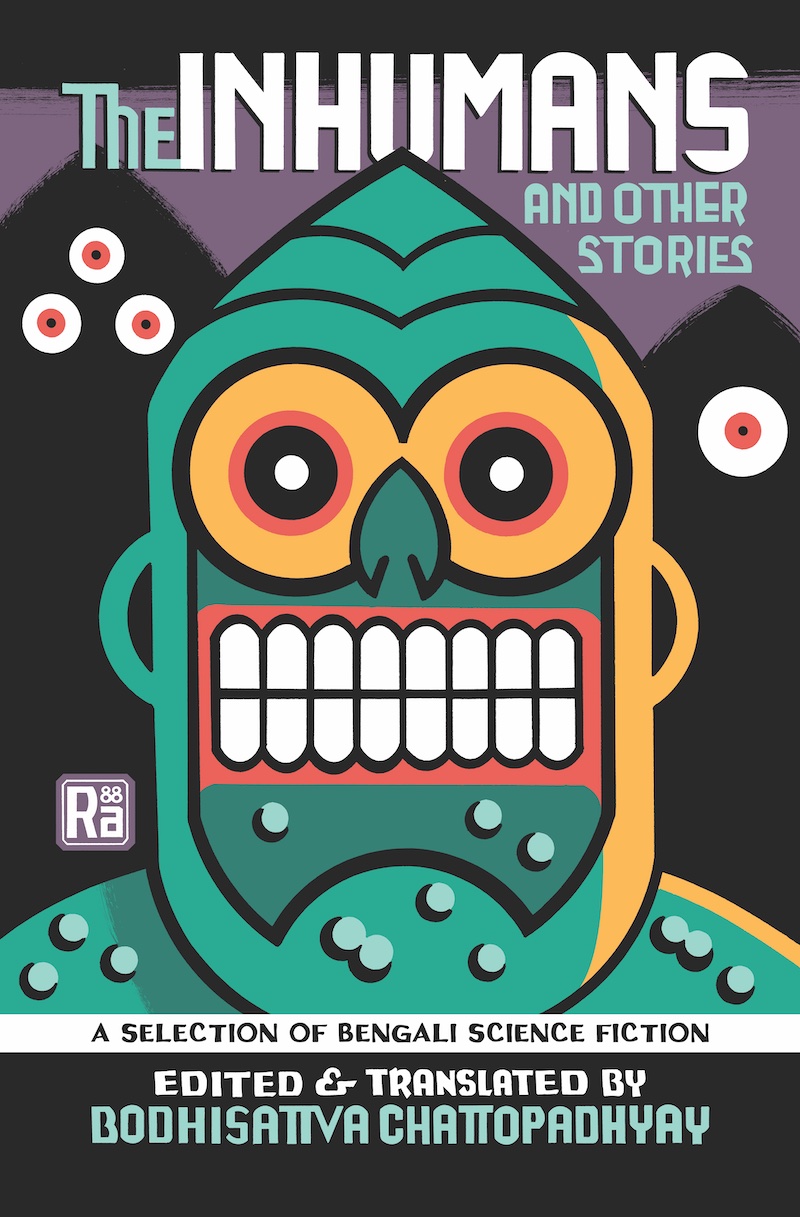
During 2023, the series’ four 2024 titles were prepped for publication…
- THE INHUMANS AND OTHER STORIES: A SELECTION OF BENGALI SCIENCE FICTION (March 12, edited and translated by Bodhisattva Chattopadhyay). “A genuine moment of science fiction’s arrival in interwar Bengal.” — Anindita Banerjee. See this title at the MIT Press website.
- Charlotte Haldane’s MAN’S WORLD (March 12, introduced by Philippa Levine). “The whole of human relations are regulated by science in this book, and the process appears to be successful and quite inhuman.” — The Spectator (1926). See this title at the MIT Press website.
- Edward Shanks’s THE PEOPLE OF THE RUINS (August 6, introduced by Paul March-Russell). “The first of the many British postwar novels that foresee Britain returned to barbarism by the ravages of war.” — Anatomy of Wonder.
- Francis Stevens’s THE HEADS OF CERBERUS AND OTHER STORIES (Sept. 17, edited and introduced by Lisa Yaszek). “Those who insist on the close reasoning and the satirical wit of modern science fiction will find surprising amounts of both here.” — Damon Knight, In Search of Wonder.
The series’ four 2025 titles are also well underway….
During 2023, Josh Glenn continued to research stories and novels for potential future publication. Also…
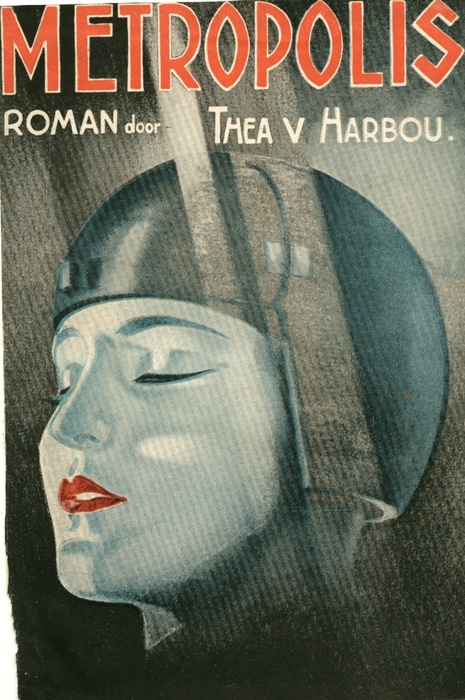
In June, HILOBROW published SISTERS OF THE RADIUM AGE — an amazing resource of proto-sf stories by women; compiled by Lisa Yaszek and her students.
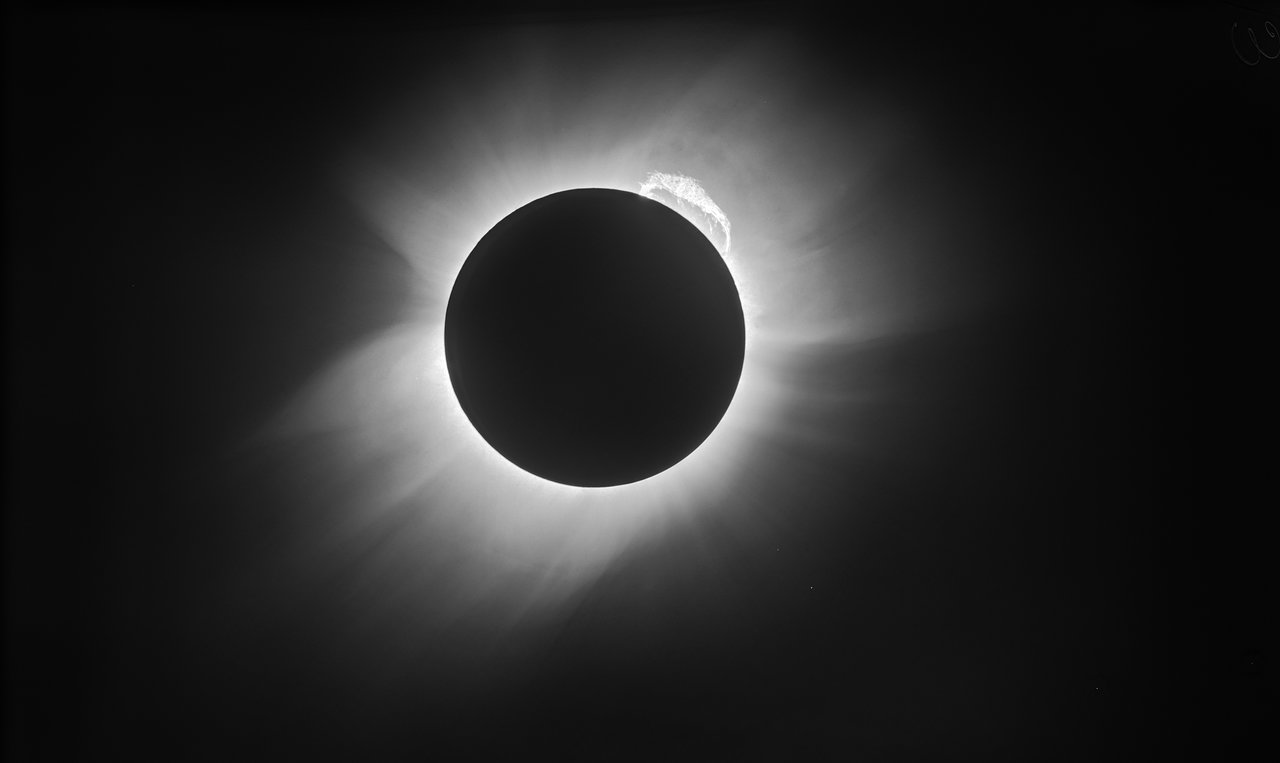
HILOBROW published dozens of installments in the RADIUM AGE POETRY series. Josh is collecting (pro- or anti-) science-, mathematics-, technology-, space-, apocalypse-, dehumanization-, disenchantment-, and/or future-oriented poem published during sf’s emergent Radium Age.
Here’s a sampling of the lineup:
D.H. Lawrence’s FUTURE WAR | Frederik Pohl’s ELEGY TO A DEAD PLANET: LUNA | Robert Frost’s FIRE AND ICE | Blaise Cendrar’s ORION | Aldous Huxley’s FIFTH PHILOSOPHER’S SONG | Sara Teasdale’s “THERE WILL COME SOFT RAINS” | Edith Södergran’s ON FOOT I HAD TO… | Edna St. Vincent Millay’s EUCLID ALONE | W.J. Turner’s IN TIME LIKE GLASS | Mina Loy’s LUNAR BAEDEKER | Robinson Jeffers’s ROAN STALLION | Velemir Khlebnikob’s “THERE IS THAT SMELL…” | D.H. Lawrence’s ROBOT FEELINGS | Irma Valeria’s LET’S LAUGH AT THE UNIVERSE | Jean Toomer’s HER LIPS ARE COPPER WIRE | & many others.
To see the full series lineup, organized thematically into such categories as CATASTROPHE, FAR-OUT MATHEMATICS, and NEW TECHNOLOGIES, please visit this page.
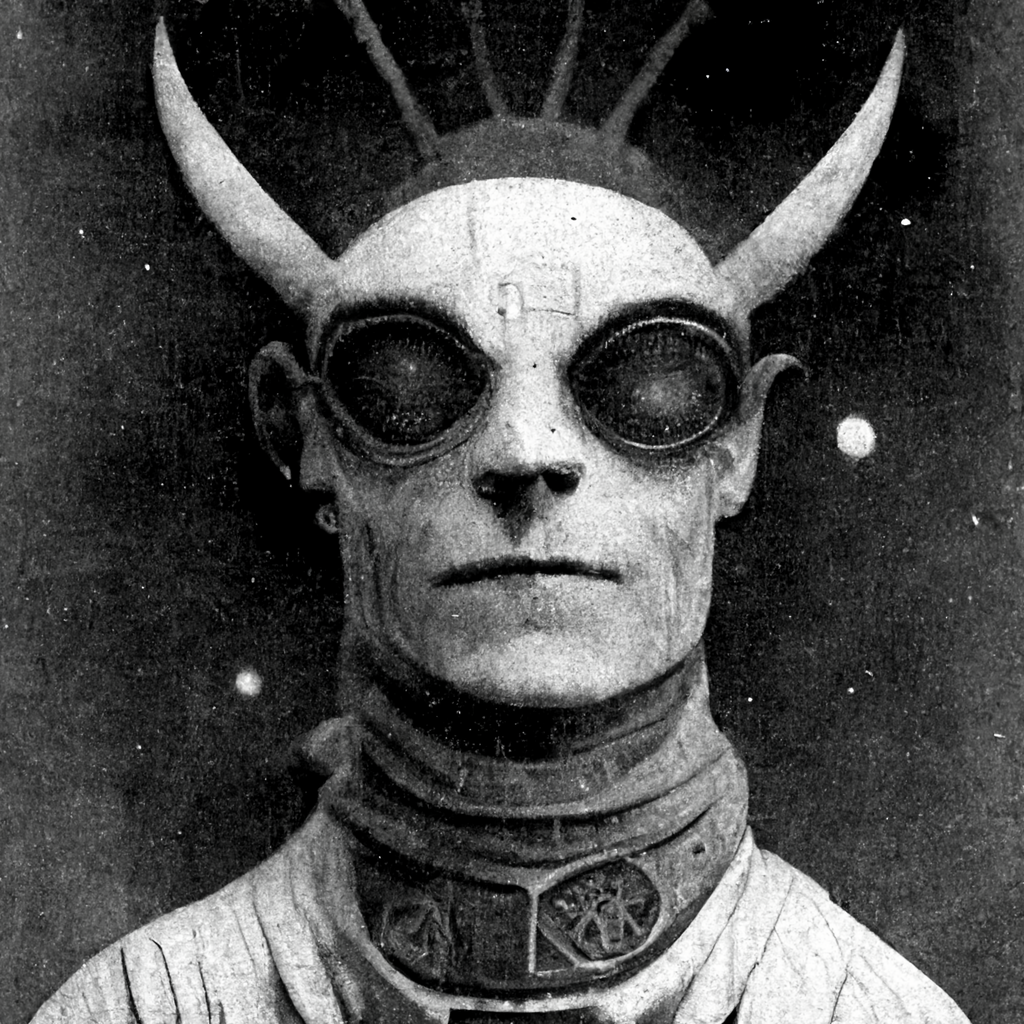
Here at HILOBROW, as we have been doing for a decade now, during 2023 we serialized a few of Josh’s favorite Radium Age proto-sf stories and novels. Here’s a sampling of what we serialized this year:
- Gertrude M. Barrows’s “The Curious Experience of Thomas Dunbar” (1904)
- Robert W. Chambers’s “The Harbor-Master” (1904)
- An excerpt from George Gurdjieff’s Beelzebub’s Tales to His Grandson (dictated 1924–1927; intended to be the first section of All and Everything)
- Mary E. Wilkins Freeman’s “The Hall Bedroom” (1903)
- Clare Winger Harris’s “The Fifth Dimension” (1928)
- Leslie F. Stone’s “When the Sun Went Out” (1929)
- Lilith Lorraine’s “The Brain of the Planet” (1929)
- John Buchan’s “Space” (1911)
- Perley Poore Sheehan and Robt. H. Davis’s “Blood and Iron” (1917)
Here’s what they’re saying about the series:
“Joshua Glenn’s admirable Radium Age series [is] devoted to early- 20th-century science fiction and fantasy.” — Michael Dirda, Washington Post | “Neglected classics of early 20th-century sci-fi in spiffily designed paperback editions.” — The Financial Times | “New editions of a host of under-discussed classics of the genre.” — Tor.com | “The best proto-science fiction novels and stories from 1900 to 1935.” — The Washington Post. | “Long live the Radium Age.” — Scott Bradfield, Los Angeles Times | “Shows that ‘proto-sf’ was being published much more widely, alongside other kinds of fiction, in a world before it emerged as a genre and became ghettoised.” — BSFA Review. | “A huge effort to help define a new era of science fiction.” — Transfer Orbit | “It’s an attractive crusade. […] Glenn’s project is well suited to providing an organizing principle for an SF reprint line, to the point where I’m a little surprised that I can’t think of other similarly high-profile examples of reprint-as-critical-advocacy. ” — The Los Angeles Review of Books | “An excellent start at showcasing the strange wonders offered by the Radium Age.” — Maximum Shelf
During 2023, the series received the following publicity:
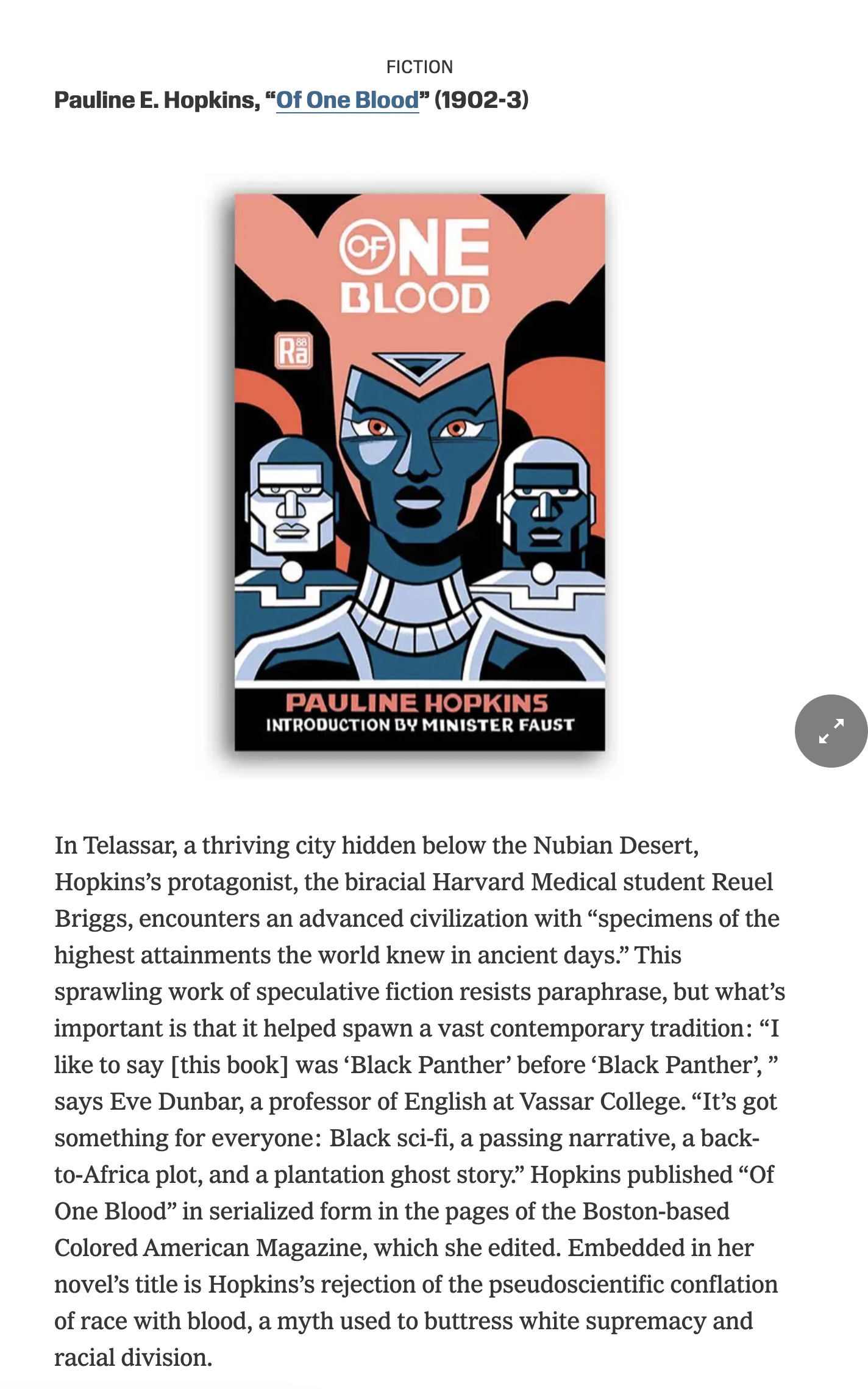
In March, Adam Bradley, founding director of the Laboratory for Race and Popular Culture at U.C.L.A., published a list of 20 books that “help to tell a story of Black American literature that reflects the infinite number of ways of being Black in America — and of being in the world.” The first book on the list is Pauline Hopkins’s Of One Blood — the edition shown is from the RADIUM AGE series. “This sprawling work of speculative fiction resists paraphrase, but what’s important is that it helped spawn a vast contemporary tradition.”
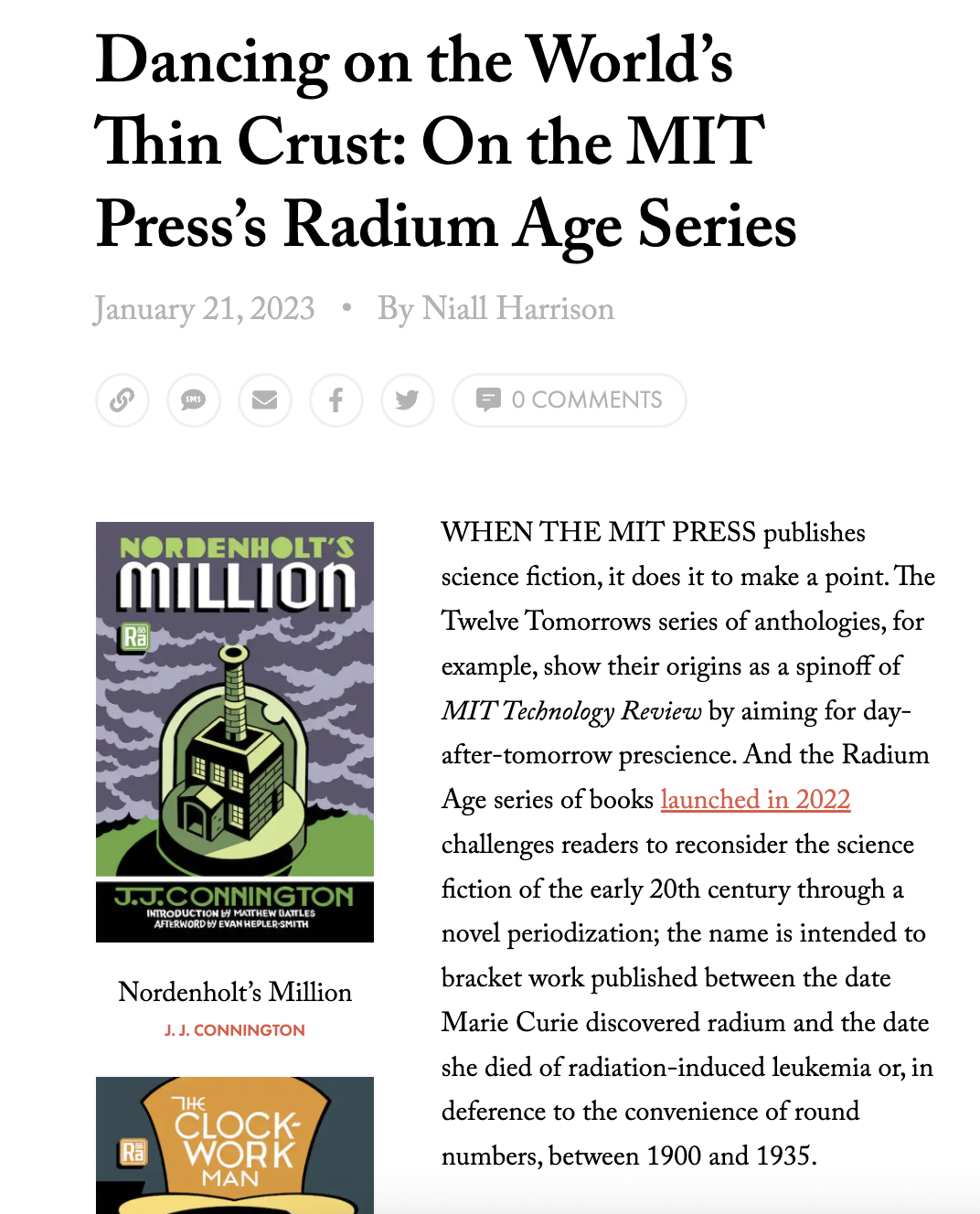
“It’s an attractive crusade,” Niall Harrison writes in a January 2023 Los Angeles Review of Books essay on the Radium Age series. In addition to comments on our editions of What Not, Nordenholt’s Million, and The Clockwork Man, Harrison has the following to say about the series itself: “Glenn’s project is well suited to providing an organizing principle for an SF reprint line, to the point where I’m a little surprised that I can’t think of other similarly high-profile examples of reprint-as-critical-advocacy.”
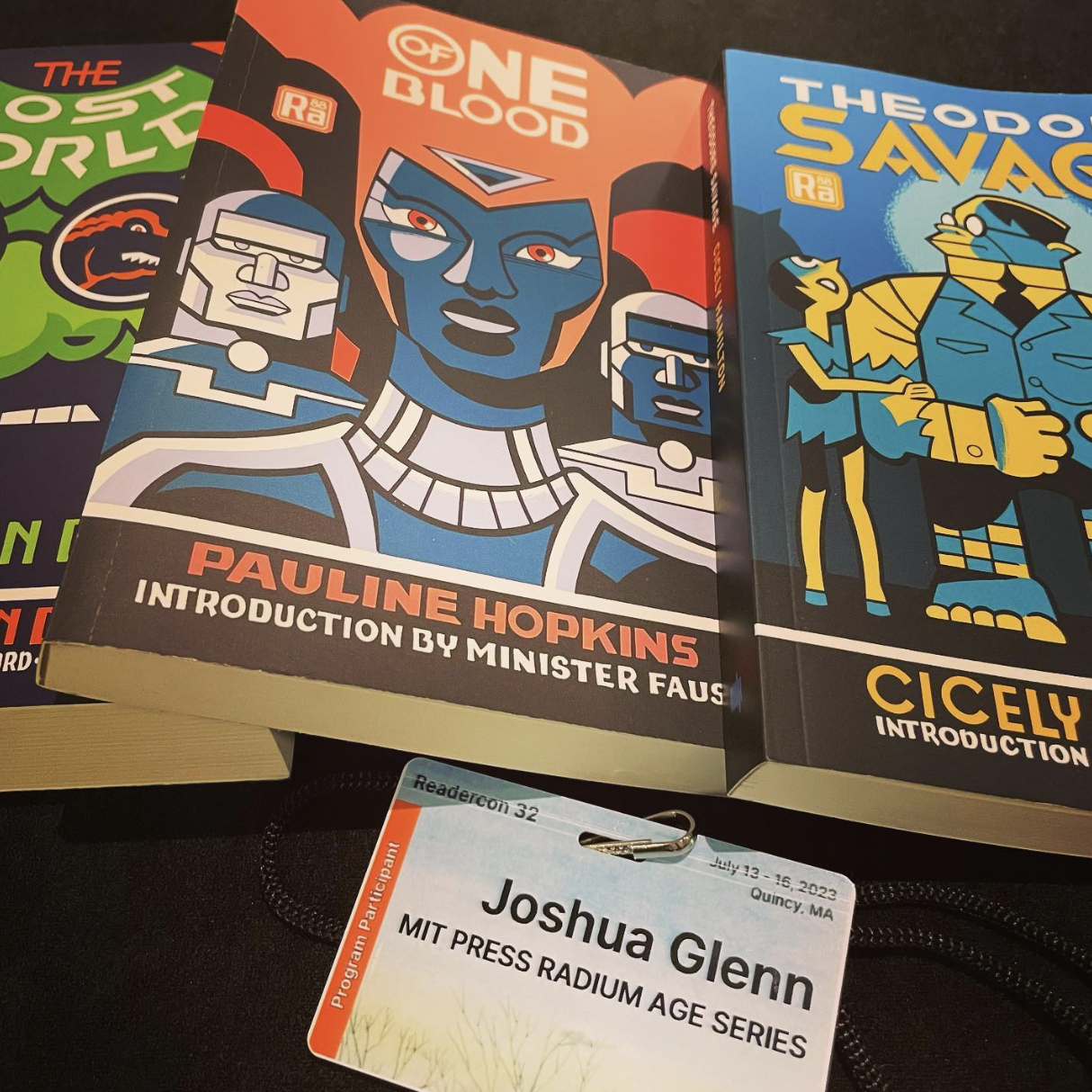
Josh participated in Readercon — an sf convention held every summer in the Boston area. He moderated three panels: SF Treasures of the Radium Age (with Annalee Newitz); How We Shape and Reshape Older Works (with Gary Wolfe, John Clute, Nadia Bulkin, and Pat Murphy); and The Pyrite Age of Science Fiction (with Gary Wolfe, Graham Sleight, Jeff Hecht, and Robert Killheffer).
Michael D. Gordin wrote a long piece about the Radium Age series (“lovingly curated by Joshua Glenn”) for the Los Angeles Review of Books. Excerpt:
“The selection of works is not so much an argument for coherence as a catch-all to enable readers to revel in its heterogeneity.” And: “The series’ freedom from genre purism lets us see how a specific set of anxieties — channeled through dystopias, Lovecraftian horror, arch social satire, and adventure tales — spurred literary experimentation and the bending of conventions.”
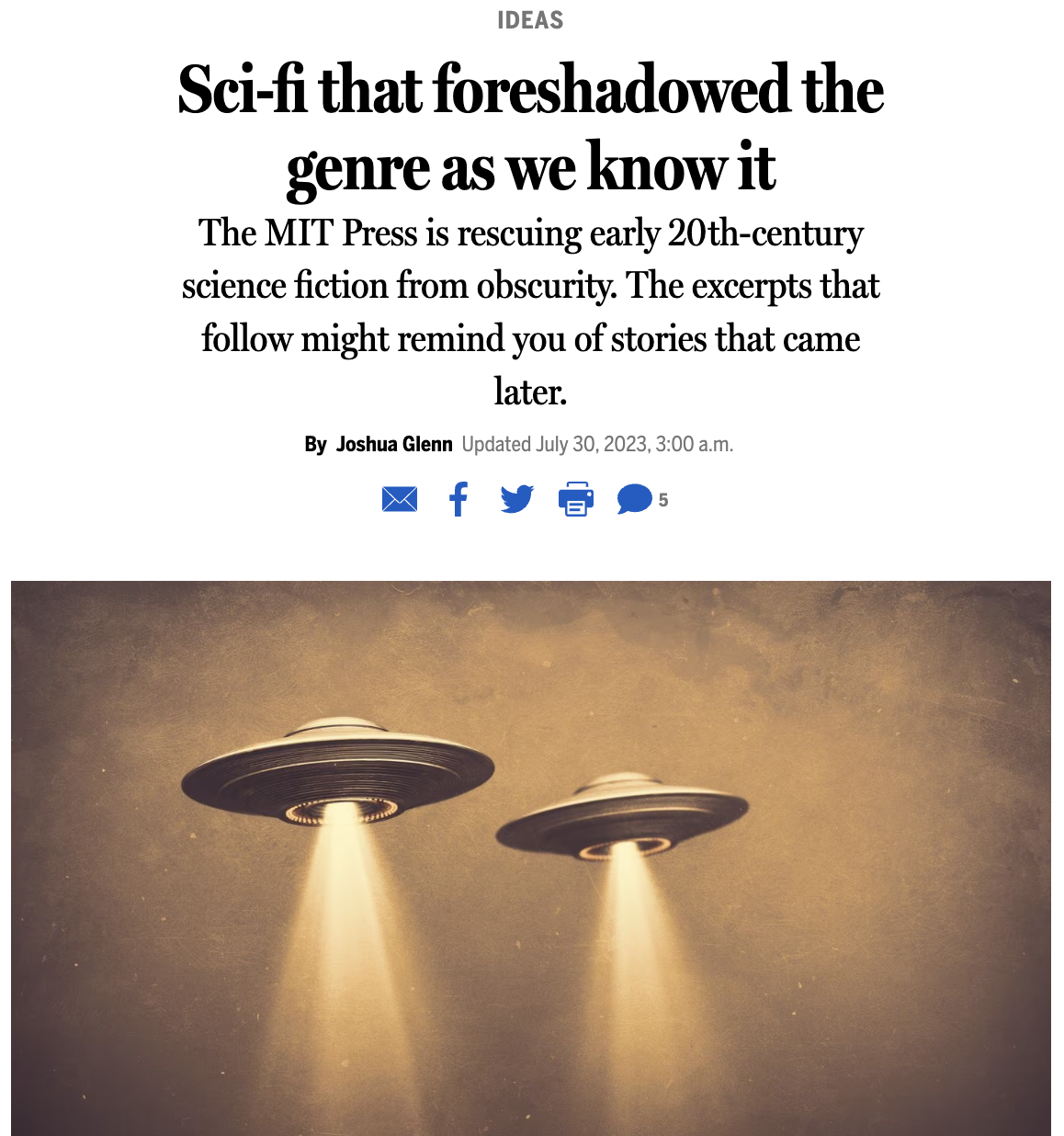
The Boston Globe‘s IDEAS section devoted an entire page to running excerpts from three stories collected in MORE VOICES FROM THE RADIUM AGE, along with some contextualizing remarks by the book’s editor.
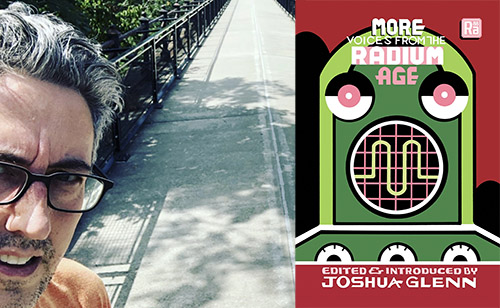
Josh was interviewed by Arley Sorg for the August issue of the sf/f magazine Clarkesworld.
LitHub published “Problems Plus Time: What Creates a Dystopia, Real or Imagined,” Madeline Ashby’s introduction to the RADIUM AGE series’ edition of G.K. Chesterton’s The Napoleon of Notting Hill.
LitHub also published Josh’s introduction to More Voices from the Radium Age.
Foreword‘s THIS WEEK newsletter published an interview with Josh about the series.
The MIT Press Reader published a short excerpt from William Hope Hodgson’s The Night Land, along with a few notes from Erik Davis’s introduction.
Sasha Karsavina published a thoughtful essay in the Los Angeles Review of Books about the MIT Press’s edition of Arthur Conan Doyle’s The Lost World and The Point Belt. Excerpt:
Written when Europe’s attempts to conquer time and space through technological means threatened to disenchant a rapidly contracting globe, Doyle’s Professor Challenger series made the planet and its processes strange again. Doyle’s late-career canon — replete with sentient planets, toxic atmospheres, and closed ecological systems — anticipates the windswept tableaux vivants of Jeff VanderMeer’s and Chen Qiufan’s contemporary climate fiction, among others.

Erik Davis was a guest on the Sept. 26 episode of Weird Studies — a podcast via which Phil Ford and J.F. Martel host conversations about “ideas that are hard to think and art that opens up rifts in what we are pleased to call ‘reality.'” The Night Land was the subject of an in-depth, fascinating discussion….
In an October 6 roundup of spooky stories for the Halloween season, Michael Dirda of The Washington Post mentioned two recent Radium Age titles: More Voices from the Radium Age (“Reprints, among other good things, A. Merritt’s ‘The People of the Pit,’ a story that could have served as the template for half of Lovecraft’s contributions to Weird Tales“) and The Night Land (“William Hope Hodgson’s extravagantly baroque vision of a desolate future Earth”).

In November, Josh was interviewed by Miranda Melcher for England’s NEW BOOKS NETWORK podcast. Excerpt:
Let me also mention Francis Stevens’s novella The Heads of Cerberus, in which three characters travel from the present time to a far-future Philadelphia, which has become a kind of fascist city-state. I bring this up because we recently had some poll results from Pennsylvania about the next presidential contest that make me quite worried about where that state is headed.
MORE RADIUM AGE SCI FI ON HILOBROW: RADIUM AGE SERIES from THE MIT PRESS: In-depth info on each book in the series; a sneak peek at what’s coming in the months ahead; the secret identity of the series’ advisory panel; and more. | RADIUM AGE: TIMELINE: Notes on proto-sf publications and related events from 1900–1935. | RADIUM AGE POETRY: Proto-sf and science-related poetry from 1900–1935. | RADIUM AGE 100: A list (now somewhat outdated) of Josh’s 100 favorite proto-sf novels from the genre’s emergent Radium Age | SISTERS OF THE RADIUM AGE: A resource compiled by Lisa Yaszek.

